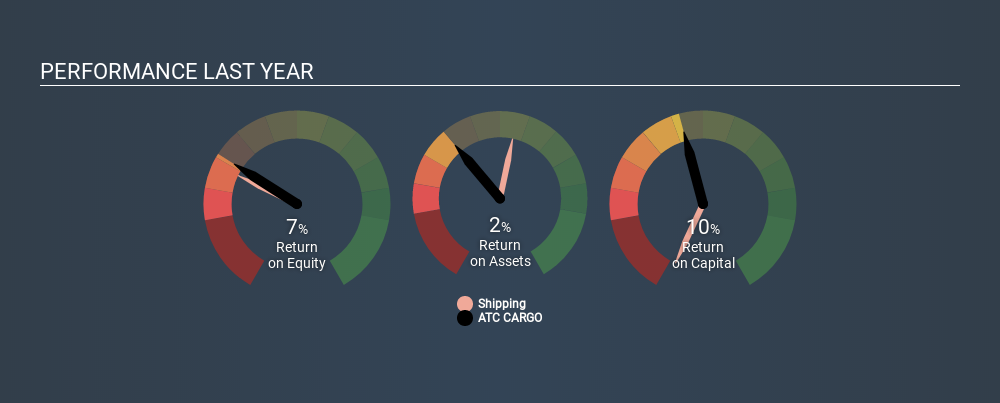
Today we are going to look at ATC CARGO S.A. (WSE:ATA) to see whether it might be an attractive investment prospect. In particular, we'll consider its Return On Capital Employed (ROCE), as that can give us insight into how profitably the company is able to employ capital in its business.
First of all, we'll work out how to calculate ROCE. Then we'll compare its ROCE to similar companies. Last but not least, we'll look at what impact its current liabilities have on its ROCE.
Understanding Return On Capital Employed (ROCE)
ROCE measures the 'return' (pre-tax profit) a company generates from capital employed in its business. All else being equal, a better business will have a higher ROCE. In brief, it is a useful tool, but it is not without drawbacks. Renowned investment researcher Michael Mauboussin has suggested that a high ROCE can indicate that 'one dollar invested in the company generates value of more than one dollar'.
How Do You Calculate Return On Capital Employed?
The formula for calculating the return on capital employed is:
Return on Capital Employed = Earnings Before Interest and Tax (EBIT) ÷ (Total Assets - Current Liabilities)
Or for ATC CARGO:
0.10 = zł2.8m ÷ (zł71m - zł44m) (Based on the trailing twelve months to September 2018.)
Therefore, ATC CARGO has an ROCE of 10%.
View our latest analysis for ATC CARGO
Is ATC CARGO's ROCE Good?
When making comparisons between similar businesses, investors may find ROCE useful. Using our data, we find that ATC CARGO's ROCE is meaningfully better than the 5.9% average in the Shipping industry. We consider this a positive sign, because it suggests it uses capital more efficiently than similar companies. Independently of how ATC CARGO compares to its industry, its ROCE in absolute terms appears decent, and the company may be worthy of closer investigation.
ATC CARGO has an ROCE of 10%, but it didn't have an ROCE 3 years ago, since it was unprofitable. This makes us wonder if the company is improving. You can see in the image below how ATC CARGO's ROCE compares to its industry. Click to see more on past growth.

Remember that this metric is backwards looking - it shows what has happened in the past, and does not accurately predict the future. Companies in cyclical industries can be difficult to understand using ROCE, as returns typically look high during boom times, and low during busts. This is because ROCE only looks at one year, instead of considering returns across a whole cycle. How cyclical is ATC CARGO? You can see for yourself by looking at this free graph of past earnings, revenue and cash flow.
Do ATC CARGO's Current Liabilities Skew Its ROCE?
Current liabilities are short term bills and invoices that need to be paid in 12 months or less. The ROCE equation subtracts current liabilities from capital employed, so a company with a lot of current liabilities appears to have less capital employed, and a higher ROCE than otherwise. To check the impact of this, we calculate if a company has high current liabilities relative to its total assets.
ATC CARGO has current liabilities of zł44m and total assets of zł71m. Therefore its current liabilities are equivalent to approximately 61% of its total assets. This is admittedly a high level of current liabilities, improving ROCE substantially.
The Bottom Line On ATC CARGO's ROCE
This ROCE is pretty good, but remember that it would look less impressive with fewer current liabilities. There might be better investments than ATC CARGO out there, but you will have to work hard to find them . These promising businesses with rapidly growing earnings might be right up your alley.
For those who like to find winning investments this free list of growing companies with recent insider purchasing, could be just the ticket.
If you spot an error that warrants correction, please contact the editor at editorial-team@simplywallst.com. This article by Simply Wall St is general in nature. It does not constitute a recommendation to buy or sell any stock, and does not take account of your objectives, or your financial situation. Simply Wall St has no position in the stocks mentioned.
We aim to bring you long-term focused research analysis driven by fundamental data. Note that our analysis may not factor in the latest price-sensitive company announcements or qualitative material. Thank you for reading.
About WSE:ATA
ATC CARGO
Provides door to door cargo transportation services by sea, road, or air in Poland and internationally.
Flawless balance sheet moderate.


